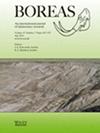Multi‐proxy palaeoenvironmental reconstruction of the Skagerrak from the Lateglacial to Middle Holocene
IF 2.4
3区 地球科学
Q2 GEOGRAPHY, PHYSICAL
引用次数: 0
Abstract
This study uses a multiproxy approach including the first use of 187Os/188Os, %C37:4 biomarkers, carbonate content, sedimentological grain size, geochemical X‐ray fluorescence and microfossil benthic foraminifera species combined with radiocarbon dating, measured on six cores from across the Skagerrak, in order to study the Lateglacial to Middle Holocene history of the area. A new chronostratigraphic framework is developed based on the appearance of specific benthic foraminifera species along with changes in carbonate/X‐ray fluorescence and grain size data. This allowed the correlation of cores based on a series of radiocarbon dated tie points. Analysing the cores together reveals several events recorded in the Skagerrak including: (i) an increased freshwater input (bracketed between 13.3 and 11.3 cal. ka BP) signified by radiogenic 187Os/188Os values, high %C37:4 values and an increase in sand content; (ii) the Glomma drainage event, signified by a sudden appearance of Valvulineria as well as higher %C37:4; and (iii) the opening of the Danish Straits and English Channel leading to the development of modern‐day conditions and circulation patterns in the Skagerrak, signified by the appearance of Hyalinea balthica and a fall in %C37:4.斯卡格拉克海峡从大冰期到全新世中期的多代理古环境重建
这项研究采用了多代理方法,包括首次使用 187Os/188Os、%C37:4 生物标志物、碳酸盐含量、沉积物粒度、地球化学 X 射线荧光和微化石底栖有孔虫物种,并结合对斯卡格拉克海峡(Skagerrak)各地的六个岩心进行的放射性碳年代测定,以研究该地区从大冰期到全新世中期的历史。根据特定底栖有孔虫物种的出现以及碳酸盐/X 射线荧光和粒度数据的变化,建立了一个新的年代地层框架。这样就可以根据一系列放射性碳年代连接点对岩心进行关联。通过对岩心进行综合分析,可以发现斯卡格拉克海峡发生的几个事件,包括:(i) 淡水输入增加(介于 13.3 和 11.3 卡(ii)Glomma排水事件,表现为Valvulineria的突然出现以及%C37:4的升高;(iii)丹麦海峡和英吉利海峡的开放导致了斯卡格拉克海峡现代条件和环流模式的发展,表现为Hyalinea balthica的出现以及%C37:4的下降。
本文章由计算机程序翻译,如有差异,请以英文原文为准。
求助全文
约1分钟内获得全文
求助全文
来源期刊

Boreas
地学-地球科学综合
CiteScore
5.90
自引率
4.50%
发文量
36
审稿时长
>12 weeks
期刊介绍:
Boreas has been published since 1972. Articles of wide international interest from all branches of Quaternary research are published. Biological as well as non-biological aspects of the Quaternary environment, in both glaciated and non-glaciated areas, are dealt with: Climate, shore displacement, glacial features, landforms, sediments, organisms and their habitat, and stratigraphical and chronological relationships.
Anticipated international interest, at least within a continent or a considerable part of it, is a main criterion for the acceptance of papers. Besides articles, short items like discussion contributions and book reviews are published.
 求助内容:
求助内容: 应助结果提醒方式:
应助结果提醒方式:


